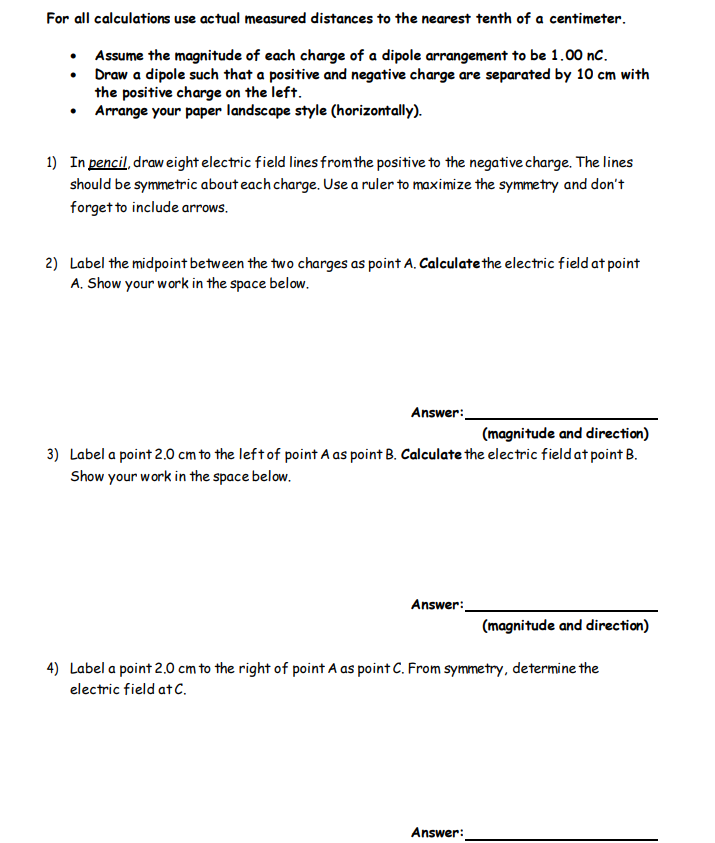For all calculations use actual measured distances to the nearest tenth of a centimeter. Assume the magnitude of each charge of a dipole arrangement to be 1.00 nC. Draw a dipole such that a positive and negative charge are separated by 10 cm with the positive charge on the left. Arrange your paper landscape style (horizontally). 1) In pencil, draw eight electric field lines from the positive to the negative charge. The lines should be symmetric about each charge. Use a ruler to maximize the symmetry and don't forget to include arrows. 2) Label the midpoint between the two charges as point A. Calculate the electric field at point A. Show your work in the space below. Answer: (magnitude and direction) 3) Label a point 2.0 cm to the left of point A as point B. Calculate the electric field at point B. Show your work in the space below. Answer: (magnitude and direction) 4) Label a point 2.0 cm to the right of point A as point C. From symmetry, determine the electric field at C. Answer:
For all calculations use actual measured distances to the nearest tenth of a centimeter. Assume the magnitude of each charge of a dipole arrangement to be 1.00 nC. Draw a dipole such that a positive and negative charge are separated by 10 cm with the positive charge on the left. Arrange your paper landscape style (horizontally). 1) In pencil, draw eight electric field lines from the positive to the negative charge. The lines should be symmetric about each charge. Use a ruler to maximize the symmetry and don't forget to include arrows. 2) Label the midpoint between the two charges as point A. Calculate the electric field at point A. Show your work in the space below. Answer: (magnitude and direction) 3) Label a point 2.0 cm to the left of point A as point B. Calculate the electric field at point B. Show your work in the space below. Answer: (magnitude and direction) 4) Label a point 2.0 cm to the right of point A as point C. From symmetry, determine the electric field at C. Answer:
Related questions
Question
I have already gotten the answers to all of the questions. All I need is the ANGLE for questions 2, 3, and 4.
Please and Thank you. If you can please explain how you got the angle.

Transcribed Image Text:For all calculations use actual measured distances to the nearest tenth of a centimeter.
•
Assume the magnitude of each charge of a dipole arrangement to be 1.00 nC.
Draw a dipole such that a positive and negative charge are separated by 10 cm with
the positive charge on the left.
Arrange your paper landscape style (horizontally).
●
1) In pencil, draw eight electric field lines from the positive to the negative charge. The lines
should be symmetric about each charge. Use a ruler to maximize the symmetry and don't
forget to include arrows.
2) Label the midpoint between the two charges as point A. Calculate the electric field at point
A. Show your work in the space below.
Answer:
(magnitude and direction)
3) Label a point 2.0 cm to the left of point A as point B. Calculate the electric field at point B.
Show your work in the space below.
Answer:
(magnitude and direction)
4) Label a point 2.0 cm to the right of point A as point C. From symmetry, determine the
electric field at C.
Answer:
Expert Solution
This question has been solved!
Explore an expertly crafted, step-by-step solution for a thorough understanding of key concepts.
This is a popular solution!
Trending now
This is a popular solution!
Step by step
Solved in 3 steps

Follow-up Questions
Read through expert solutions to related follow-up questions below.
Follow-up Question
Thank you for the explanation, but this didn't answer my question. I need to know the angles for qeustion 2, 3, and 4. With explanations on how to get them.
Solution